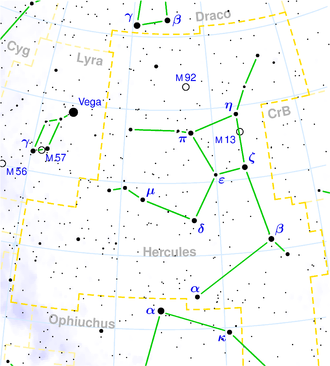NGC 6580
| Galaxy NGC 6580 |
|
|---|---|
|
|
|
| AladinLite | |
| Constellation | Hercules |
|
Position equinox : J2000.0 , epoch : J2000.0 |
|
| Right ascension | 18 h 12 m 33.70 s |
| declination | + 21 ° 25 ′ 34.1 ″ |
| Appearance | |
| Morphological type | E. |
| Brightness (visual) | 13.1 mag |
| Brightness (B-band) | 14.1 mag |
| Angular expansion | 1.3 ′ × 0.7 ′ |
| Position angle | 135 ° |
| Surface brightness | 13.1 mag / arcmin² |
| Physical data | |
| Redshift | 0.019490 ± 0.000230 |
| Radial velocity | 5843 ± 69 km / s |
|
Stroke distance v rad / H 0 |
(269 ± 19) · 10 6 ly (82.4 ± 5.8) Mpc |
| history | |
| discovery | Albert Marth |
| Discovery date | August 7, 1864 |
| Catalog names | |
| NGC 6580 • UGC 11153 N02 • PGC 61566 • CGCG 142-022 N02 • MCG + 04-43-012 • 2MASX J18123372 + 2125338 • GC 5901 • WISEA J181233.68 + 212534.2 • LDCE 1291 NED007 • HOLM 775A | |
NGC 6580 is a 13.1 mag bright elliptical galaxy of the Hubble type E5 in the constellation Hercules in the northern sky . It is estimated to be 269 million light years from the Milky Way and about 100,000 light years in diameter. Together with NGC 6579 , it forms the (optical) galaxy pair Holm 775 .
In the same area of the sky are u. a. the galaxies NGC 6571 , NGC 6576 , NGC 6577 , NGC 6586 .
The object was discovered by Albert Marth on August 7, 1864 .
Web links
- NGC 6580. SIMBAD , accessed September 19, 2019 .
- NGC 6580. DSO Browser, accessed September 19, 2016 .
- Auke Slotegraaf : NGC 6580. Deep Sky Observer's Companion, accessed on September 19, 2016 (English).
- Aladin Lite: NGC 6580
